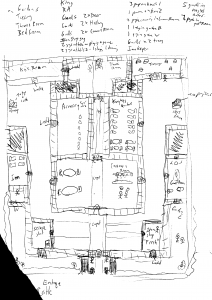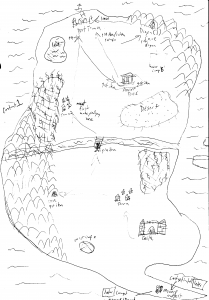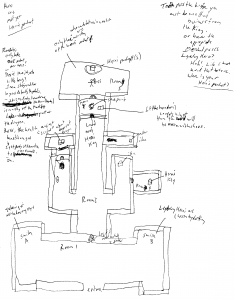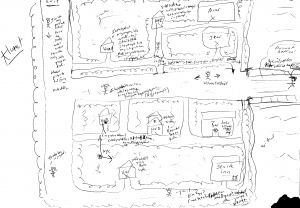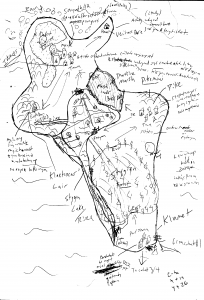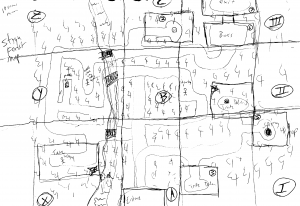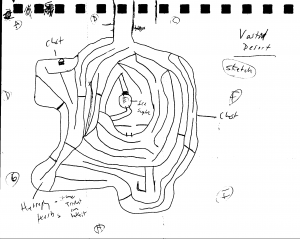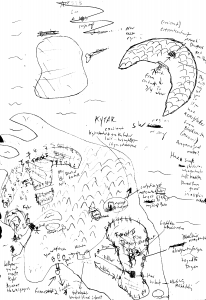I’ve been meaning to do this for a long time now, but well, life happened.
I’ve kept a good majority of all the game designs I’ve worked on. I think it would be nice for budding game designers to see how some of the magic really works. And I figured it would be a hoot for some fans to see how Arvale originally looked on paper by my hands.
There’s far too much material to go into one post, so I’ll spread it out for you and divide it into the three Arvale games. That way there is some cohesion and I can touch on different topics throughout. So we’ll logically start with:
Arvale: Journey of Illusion.
Design note: While some big-name game designers may say they use all sort of really fancy programs to design their games. I’m pretty sure at the end of the day, everything starts and ends up scribbled on paper.
This is all from lots of sketches and notes that went into several notebooks over the course of the 5 or so years during the production of the Windows Mobile Arvale games.
I scanned them all at pretty high quality, so if you are curious, you can zoom in and try to decipher what the hell I was thinking at the time of the design. But, don’t laugh at my handwriting. Okay, go ahead and laugh at it, I already mentioned here that I have terrible handwriting.
This should be familiar to anyone who has played Arvale: JOI. This is the first castle in the game, it is pretty much the first map that was ever made in the engine, and it came out pretty close to this very rough sketch you see here.
At this point in development, no one on the team really knew what to expect, and I wrote a lot of extra information that I don’t really bother with (at the top of the map) anymore. Stuff like King, Ra, Guards X 2 at the door are a waste of space when I already have beautiful stick figures on the map itself. Later on, if the stick figure was important enough, I would scribble their name next to it.
There are also some strange notes like ‘Carpet‘ and ‘Garden E/W‘, which I imagine were put in because the map engine and all the tiles for the game were not even finished at the time when I started designing the game.
I have no idea what ‘Fresh‘ means in the Item Shop. I’m sure it was a funny joke at the time, but I don’t remember putting it in the game.
Here is a sketch of the first continent from the game, simply called Entoque Continent, named after its capital, I didn’t think it needed another name, and it stuck.
However, you’ll notice in the picture, it’s simply called Continent 1. Castle, Cave, Town, Monster Camp, Ancient Ruins, Town 2, Port Town, and Dragon Cave all make an appearance 🙂 Oh, and Magicorp Outpost, which was an early name for Sorcynth (Sorcery+Synthesis, which is way better).
Also notice the arrows/lines pointing from the locations with short notes about where the player will go and what they will do. Crazily enough, at the Magicorp Sorcynth Outpost at the bottom, you can kinda see: ‘Later, Can get ID Card‘.
This means either:
- I had thought the outline of the game that far ahead before even naming the first town;
- I had thought of the idea at some point that outpost will be used for an ID card quest later in the game; or possibly…
- I came back and wrote it in to make myself feel smarter. I don’t remember which.
This points towards the outline of the game was written without fleshed out names of areas, towns, continents, dungeons first. At the time it was essential to get the project moving. Now, I actually think of names as soon as I am outlining the story. Which you’ll see as the designs progress.
It feels like I’m playing the pencil and paper version of Arvale: JOI now. 🙂
This is the Heroes Cave. It was meant to be a really simple cave with two puzzles and only a few rooms. It didn’t change too much aside from the Hero’s Key being hard to find in that far right room. That’s a slight problem with the mapping engine and using a 3/4 top-down view: It’s really hard to show the player there is a door on the right/left side of the player, the same problem applied to the Armory and the Guards’ Room in the castle. We solved it with different tile-sets in future games.
You’ll see I jotted down some dialogue ideas for the Dungeon Boss and I believe the Bridge Guard near the top. It seemed appropriate place to put it. Asking the Boss, ‘Doesn’t this job get a little boring?‘ after winning the fight is still one of my favorite questions from Duncan. 🙂
Also notice how there is a Save Point, which was later taken out of the game for obvious reasons (it’s a mobile game, you can save wherever you want). This led to the question… well, what do we do with all the save points in the game then? The interesting solution was the Sorcynth Points which let you boost your stats for money; which would still give the players a visual cue that a boss is coming up, and make them save so they could try the boss with and without the boosting stuff (and waste a lot less time leveling up just for a boss battle, if they so desired). I still like the Sorcynth Points.
This ugly busy picture was of a later town, Klumet (see? it has a name now). Also notice the dialogue and quest notes next to any important buildings or characters.
A strange thing I just noticed while looking at this is some NPC talking about making sure to bring enough Fire Magic to the woods. I think this was with an older magic system we planned on implementing but which never materialized. So this guy got replaced with the Soap Quest (which people are still searching for the solution to 🙂 ).
Those stick figures are awesome.
Yes Stygia, like the underworld, like the river Styx and all that. I’m not sure if the name or the Ferryman came first. Either way, it was a good fit.
A lot more arrows and a lot more notes. This was a pretty busy continent with the traveling all the way to Idraces on the north end, through the Marsh, and then traveling back to Klumet to escape to the next continent. The Ferryman and the Ferry Ticket solved this traveling back issue and that was how it was planned (that’s why the river runs through the Forest, and there is a boat stop at Pike, Idraces and Klumet).
It looks like I still hadn’t decided to make the monster camp near Pike into the cave which hints at Blynt’s (Duncan’s ancestor) story of after he left Arhaeldem. Someday, I’ll explain it all, unless someone makes a really good guess at it first 😉
I have no idea what Entoque X+ 19 and Y+ 26 means 🙂
Here is an excellent example of an interestingly bad map design.
While I’m sure that Stygian Forest actually ended up something like this… I have no idea what any of these numbers, letters, or roman numerals mean today. It’s obvious that I was trying to divide up the map into screens somehow…
Ah, I see. Creative, but still messy. Since it wasn’t exactly on a grid, I needed someway to have the exits/entrances from each map organized by name somehow in the map editor. This gets confusing because even from space ‘A’, there are 5 exits, 2 of which are both on the top of the screen. Exits in the game were all handled by step-on triggers, with entry and exit points (where to place the character on the next map).
Therefore, just estimating by the looks of it, this map probably has about 50 exit triggers. This doesn’t include that a trigger had to be placed on one tile at a time (this changed in Arvale II engine, thankfully).
Anyway, if you’re designing some part of a game, and come across some problem and solve it with a weird, creative solution: write down WHY you did it, so you can read it later.
Strangely enough, this one:
Is a much more complicated map, yet a lot easier to read (even if the scanner didn’t pick everything up correctly). This seems to be much later in the game.
You may wonder why ABC,DEF,GHI and not use ABC horizontal and 123 vertical, something more like Chess or Battleship (I’m sure there is a more accurate word for this); e.g. A-2, or C-9. I’m sure there are a few good reasons I didn’t. Aside from only having 9 screens and adding numbers would be overkill, I would get confused sharing A with 0. 😉 Besides, this way I can say the Ice Scepter is simply on E (not B-2).
And for those still searching for the Hydrephyl Herbs, there they are, in G. 🙂
Okay one more:
Ah, memories. That blob on the left side was supposed to be another continent which never made it into the game. It was going to be a tie-in with another game (by another developer) called Medieval Blacksmith, which never saw the light of day.
When that fell through, I tied it in with an existing game by PDAmill Game Studios, GameBox Gems (and all of its Dwarves). This set the perfect stage for hunting for Mythril and well, it worked out even better. The Melonchi Mines in turn, had lots of gameplay in Arvale II, and even a spin-off game of its own called Melonchi Minecarts was created.
Kytar itself was another game (by another developer) which was supposed to be tied into Arvale. That other game was supposed to take place on the northern part of the continent. And that other game was slated to be released within a few months after Arvale 1. That’s why the guard is on the bridge there, and that is why the cryptic message he gives you about not being able to cross the bridge until months later.
Unfortunately, that project fell through too, but the developer was kind enough to let me keep the name and the resemblance to his Kytar continent. Unfortunately, this spurred a lot of player questions about what the guard means by ‘In a few months.’ I couldn’t imagine any player thinking that if he actually waited in-game for months to see if the guard would change his response.
Live and learn.
I decided to solve the Kytar dilemma in Arvale II.
In Arvale II, I allowed the player to visit that other side of the continent, but not the original side in Arvale 1. And this time, I put a visibly broken bridge and a readable sign saying ‘The bridge is broken and there is absolutely no way you are going to cross it or get to that side of the continent.’ 🙂
Arvale II fixed a lot of things, as far as design, gameplay, but also introduced a few new challenges. So…
In the next set, I’ll use Arvale II: OOT examples, and I’ll touch on topics such as designing the story outline, puzzles, the big problems with time/dimensional traveling, and even designs for the music and sound files. If you have any comments, questions, or suggestions, be sure to leave them at the end of this post and I’ll be sure to answer them or include them in future installments.
Thanks for reading, and thanks for playing!
Continue reading onto Arvale Game Designs on Paper, Part 2.


